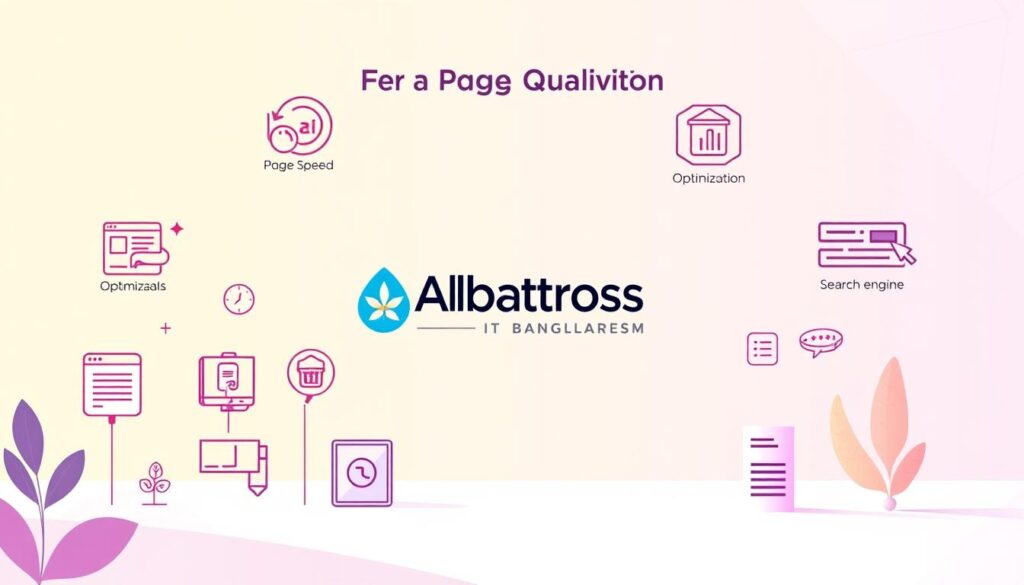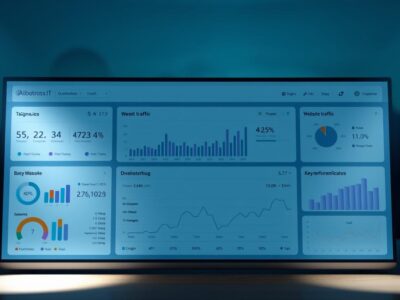In today’s digital landscape, having a website is just the first step towards establishing an online presence. To truly unlock your website’s potential, you need to ensure it is optimized for search engines. This is where website optimization comes into play.
On-page optimization is crucial for improving your website’s visibility and driving more traffic to your site. By optimizing elements on your website, you can significantly enhance your search engine ranking, making it more likely for users to find you.
At Albatross IT Bangladesh, we understand the importance of a well-optimized website. Our expertise in website optimization can help you achieve your online goals.
Key Takeaways
- On-page optimization is vital for improving website visibility.
- Optimizing website elements enhances search engine ranking.
- A well-optimized website drives more traffic and boosts online presence.
- Expertise in website optimization is crucial for achieving online goals.
- Albatross IT Bangladesh offers professional website optimization services.
What Is On-Page Optimization and Why It Matters
To understand the significance of on-page optimization, it’s essential to grasp its definition and core components. On-page optimization refers to the process of optimizing individual web pages to rank higher in search engines and improve user experience.
Definition and Core Components
On-page optimization involves several key elements, including keyword research, meta tags, and content optimization. These components work together to make a website more search engine friendly.
Difference Between On-Page and Off-Page SEO
On-page SEO focuses on optimizing website elements, whereas off-page SEO involves building the site’s reputation through external means, such as backlinks. Understanding this difference is crucial for a comprehensive SEO strategy.
Impact on Search Engine Rankings
On-page optimization significantly impacts search engine rankings. By following SEO best practices, websites can improve their visibility and ranking.
How Google Evaluates On-Page Factors
Google evaluates on-page factors, including content quality, keyword usage, and meta tags, to determine a website’s relevance and ranking.  Proper optimization can lead to better search engine rankings and increased online visibility.
Proper optimization can lead to better search engine rankings and increased online visibility.
Essential On-Page Optimization Techniques
To unlock your website’s full potential, mastering on-page optimization techniques is essential. These techniques not only improve your website’s visibility on search engines but also enhance the user experience.
Strategic Keyword Research
Strategic keyword research is the foundation of effective on-page optimization. It involves identifying the terms and phrases your target audience uses when searching for content like yours.
Finding High-Value Keywords
To find high-value keywords, use tools like Google Keyword Planner or Ahrefs to analyze search volume and competition. Focus on long-tail keywords that have lower competition and higher conversion rates.
Keyword Placement Best Practices
Once you’ve identified your target keywords, place them strategically in your content, including in the title, headings, and throughout the body. However, ensure that the keyword density remains natural and doesn’t exceed 2%.

Meta Tags and Title Optimization
Meta tags and title optimization are critical for search engine results pages (SERPs). They provide search engines with crucial information about your webpage’s content.
Crafting Effective Title Tags
Your title tag should be descriptive, concise, and compelling. It should include your primary keyword and entice users to click through to your site.
Writing Compelling Meta Descriptions
A well-written meta description can significantly improve click-through rates. Ensure it’s accurate, informative, and includes your target keyword.
Content Optimization Strategies
High-quality, relevant content is paramount for on-page optimization. It should provide value to your readers and be optimized for your target keywords.
Creating High-Quality, Relevant Content
Focus on creating content that is engaging, informative, and addresses the needs of your audience. Use proper heading structures (H1-H6) to organize your content and improve readability.
Proper Heading Structure (H1-H6)
A proper heading structure helps search engines understand your content’s hierarchy and context. Use H1 for the main title, and subsequent headings (H2-H6) to subdivide your content logically.
Internal Linking Structure
A well-planned internal linking structure helps users navigate your site and improves search engine crawling.
Strategic Link Placement
Place internal links strategically within your content to guide users to related information and improve your site’s overall structure.
Anchor Text Best Practices
Use descriptive and concise anchor text for your internal links. Avoid using generic text like “click here” and instead use text that informs users about the linked content.
Technical Aspects of On-Page Optimization
To maximize a website’s potential, it’s essential to focus on the technical aspects of on-page optimization. This involves several key areas that directly impact how search engines crawl, index, and rank a site.
Website Speed Optimization
Website speed is a critical factor in user experience and search engine rankings. Optimizing images through compression and proper file formatting can significantly reduce load times.
Image Compression and File Optimization
Compressing images without sacrificing quality is a straightforward way to improve page load times. Using the right file formats, such as WebP, can also enhance performance.
Browser Caching and Code Minification
Implementing browser caching allows repeat visitors to load your site faster by storing static resources locally. Minifying code by removing unnecessary characters and whitespace further reduces file sizes.
Mobile-Friendly Design
With the majority of web traffic coming from mobile devices, a mobile-friendly design is no longer optional. Ensuring a responsive design that adapts to various screen sizes is crucial.
Responsive Design Implementation
A responsive design automatically adjusts the layout and content to fit different devices, providing a seamless user experience across platforms.
URL Structure and Site Architecture
A well-organized URL structure and site architecture help search engines understand a website’s hierarchy and content.
Creating SEO-Friendly URLs
Using descriptive, concise URLs that include target keywords can improve a page’s visibility in search results.
Conclusion: Taking Your Website to the Next Level
Effective on-page optimization is crucial for improving your website’s search engine ranking and overall online presence. By implementing the strategies discussed, such as strategic keyword research, meta tags optimization, and content optimization, you can significantly enhance your website’s visibility.
Optimizing your website’s technical aspects, including website speed and mobile-friendliness, also plays a vital role in on-page optimization. By focusing on these elements, you can create a seamless user experience and improve your website’s search engine ranking.
By applying these on-page optimization techniques, you can take your website to the next level, driving more traffic and boosting your online success. Start optimizing your website today and watch your online presence flourish.


